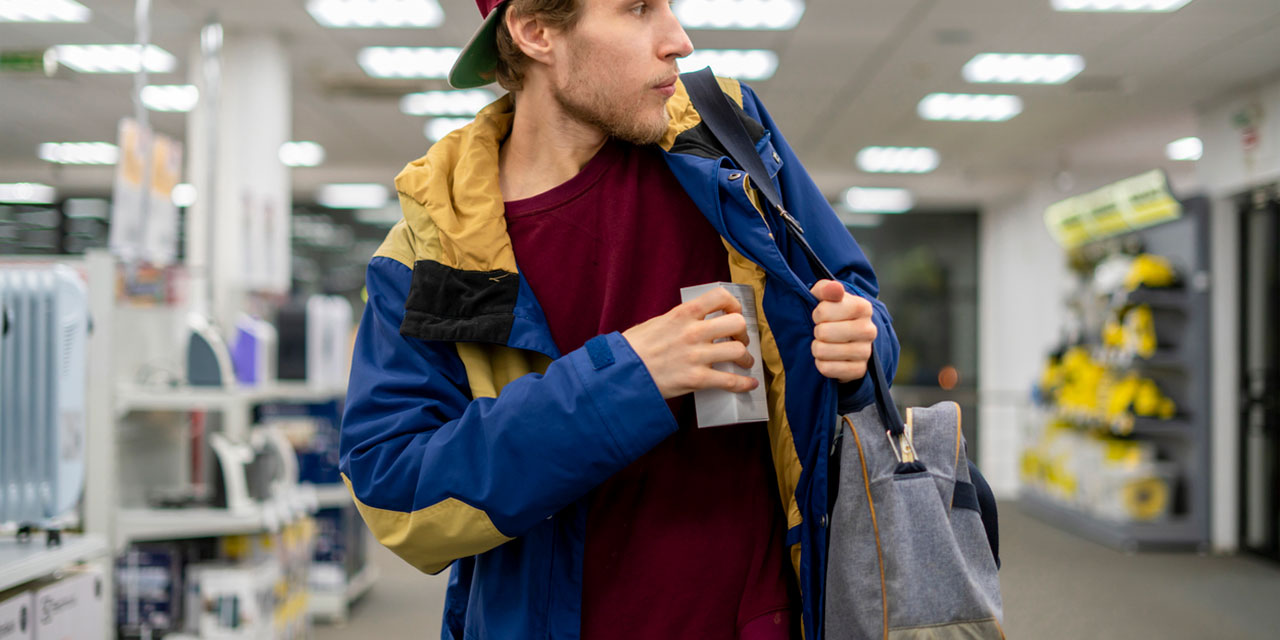A recent video on Twitter showed a supermarket employee tussling with a shoplifter who had filled her bag with items. As the employee pulled the bag from her hand, she cried, “I have to feed my family!” That’s a common refrain from shoplifters these days, echoed in media headlines proclaiming that people have turned to stealing to put food on the table—despite a U.S. social safety net that includes $185 billion in spending on food stamps and other nutrition-assistance programs. In truth, America’s exploding shoplifting problem predates our current economic difficulties. Much of the stealing, store owners and security experts say, has less to do with putting food on the table than with a rise in organized theft, and it’s having a particularly adverse effect in cities where criminal-justice reforms have made it easy to get away with.
Retail theft in America has grown to a $94 billion epidemic, according to the National Retail Federation—a staggering 90 percent increase since 2018. Retailers say that the problem gained momentum about a decade ago, when states began decriminalizing low-level shoplifting, raising the value of goods that a person must steal to enable prosecutors to bring felony charges. More than two-thirds of states now treat shoplifting as a misdemeanor if someone boosts less than $1,000 in goods, and 15 states have raised their limit to $1,500 or more. More than 70 percent of surveyed retailers reported that shoplifting spiked in their stores after these changes. Bail reforms that free without bond those arrested for shoplifting have also contributed to the problem. An official of the Association of Certified Anti–Money Laundering Specialists says that retail theft is now “a low-risk and high-reward line of business.”
Finally, a reason to check your email.
Sign up for our free newsletter today.
Rampant shoplifting is undermining retailer profits and vaporizing jobs. Walmart announced the closure of its only store in disorder-plagued Portland, Oregon, along with four stores in crime-wracked Chicago. Target, which estimated that retail theft cost it half a billion dollars last year, is shuttering stores in several cities, including Baltimore. Rite Aid is shutting down stores in New York City after the company’s chief executive described how hard it is to stop theft there. Whole Foods closed its flagship San Francisco store after one year because of rampant theft. The CEO of Home Depot told Wall Street analysts that shoplifting threatens its bottom line. “The country has a retail theft problem,” he said.
Organized retail crime now accounts for about half of store losses from theft. It has nothing to do with obtaining food for families; it’s about reselling stolen items for profit. Underlying the crime wave is the emergence of a sophisticated illegal infrastructure for recruiting shoplifters—everyone from gang members to illegal aliens—and disposing of the goods they heist. Gone are the days when petty criminals needed to sell goods through “fences” like legendary London underworld figure Ikey Solomon, so notorious for selling stolen goods from his Bell Lane jewelry shop that Charles Dickens based Fagin in Oliver Twist on him. Much of the merchandise grabbed today by shoplifters, called “boosters,” is sold by operators online—where they are hard to detect or track down. The illegal industry also includes “cleaners,” who strip goods of security devices or repackage stolen items, and money launderers, who process the transactions.
Many operations initially thrived selling on third-party online platforms like Amazon and eBay, where they blend in among legitimate sellers. The federal INFORM Consumers Act, passed last December, now requires these markets to collect information from third-party retailers. So the fencing business is moving to classified-advertising sites like Craigslist and to Facebook Marketplace, according to the National Retail Federation. While incidents of stealing luxury goods—like the flash mob that stripped a Louis Vuitton store in San Francisco in 2021—make headlines, the real money is in everyday items from mass-market retailers. A Craigslist search by security experts found that the top item under listings that appeared to be stolen merchandise were Tide Pods. Also high on the list were diapers, makeup, and baby formula. Even so, a Washington Post story headlined “Stealing to Survive” jumped to the wrongheaded conclusion that a rise in shoplifting was linked to economic need because much of it involved everyday products like baby formula.
Social media has contributed to cultural shifts that portray shoplifting as a “harmless” property crime that damages only “rich” companies. Social-media sites offer tips and how-to videos on shoplifting. They also increasingly feature anticapitalist rhetoric among young people, who claim that shoplifting is a way of “tackling the system.” In England, a TikTok “shoplifting challenge” sparked a spate of attacks on local shops. The discussion site Reddit has hosted conversations on “best practices,” including instructions to avoid being stopped by a door-checker at Walmart and why stores of the supermarket chain Publix are easy marks.
The consequences are growing. Beyond massive retailer losses, states and cities are forfeiting some $15 billion annually in sales taxes. And more than half of retailers surveyed last year said that shoplifting incidents are becoming more violent. Last November, a shoplifter killed a security guard in a Maryland supermarket who tried to detain him, and another murdered a Home Depot guard in April. In San Francisco, authorities declined to press charges against a security guard who killed a shoplifter in Walgreens because they determined that the guard’s life was in danger.
Under pressure, the Department of Homeland Security and Immigration and Customs Enforcement have begun focusing on organized retail crime, especially “smash and grab” rings. Retailers are also lobbying for passage of the Combating Organized Retail Crime Act, which establishes a unit within Homeland Security to address the issue. Some states are also cracking down.
It remains to be seen, however, whether these efforts will be enough to reverse the incentives created by de facto retail-theft decriminalization and revolving-door bail “reform” policies.
Photo: Михаил Руденко/iStock

